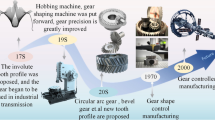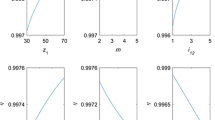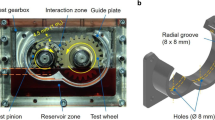Abstract
A molecular bevel gear with triptycene as the rotator and naphtha[2,1,8-def]isoquinoline as the stator was designed, and the rotational process and conformational transformation of the gear were calculated and analyzed by density functional theory. To be specific, the rotational potential energy surface was investigated via scanning the dihedral angle θ (H71‒N67‒C1‒C5). The geometry optimization was performed at the M06-2X level in conjunction with def-TZVP basis set. According to the correlation between the two rotors, the rotation mode of gear can be defined as gear rotation and gear slippage. And the rotational energy barrier indicated that the gear rotation was easier than gear slippage. For transition-state and ground-state structures, the single-point energy and thermodynamic correction were calculated at M06-2X/def2-TZVP levels. The C2 conformations in ground state achieved its stable structure owing to intramolecular hydrogen bonding, C‒H···π, and π···π stacking interactions. In order to gain insight into the intramolecular interaction, the noncovalent interactions based on the reduced density gradient method and Bader’s atoms in molecules theory were analyzed in detail.







Similar content being viewed by others
References
Tseng T, Lu HF, Kao CY, Chiu CW, Chao I, Prabhakar C, Yang JS (2017) Redox-gated tristable molecular brakes of geared rotation. J Org Chem 82(10):5354–5366
Kay ER, Leigh DA, Zerbetto F (2007) Synthetic molecular motors and mechanical machines. Angew Chem Int Ed 46(1–2):72–191
Ballardini R, Balzani V, Credi A, Gandolfi MT, Venturi M (2001) Artificial molecular-level machines: which energy to make them work? Acc Chem Res 34:445
Zheng YB, Hao QZ, Yang YW, Kiraly B, Chiang IK, Huang TJ (2010) Light-driven artificial molecular machines. J Nanophoton 4:042501
Sauvage JP (1998) Transition metal-containing rotaxanes and catenanes in motion: toward molecular machines and motors. Acc Chem Res 31:611
Blanco V, Leigh DA, Marcos V, Morales-Serna JA, Nussbaumer AL (2014) A switchable [2]rotaxane asymmetric organocatalyst that utilizes an acyclic chiral secondary amine. J Am Chem Soc 136(13):4905–4908
De S, Pramanik S, Schmittel M (2014) A toggle nanoswitch alternately controlling two catalytic reactions. Angew Chem Int Ed 53(51):14255–14259
Cheng CY, McGonigal PR, Schneebeli ST, Li H, Vermeulen NA, Ke CF, Stoddart JF (2015) An artificial molecular pump. Nat Nanotechnol 10:547–553
Leigh DA (2016) Genesis of the nanomachines: the 2016 nobel prize in chemistry. Angew Chem Int Ed 55(47):14506–14508
Feringa BL (2007) The art of building small: from molecular switches to molecular motors. J Org Chem 72:6635
Coutrot F, Romuald C, Busseron E (2008) A new pH-switchable dimannosyl[c2]Daisy chain molecular machine. Org Lett 10:3477–3741
Norikane Y, Tamaoki N (2004) Light-driven molecular hinge: a new molecular machine showing a light-intensity-dependent photoresponse that utilizes the trans—cis isomerization of azobenzene. Org Lett 6:2595–2598
Muraoka T, Kinbara K, Kobayashi Y, Aida T (2003) Light-driven open—close motion of chiral molecular scissors. J Am Chem Soc 125:5612
Kottas GS, Clarke LI, Horinek D, Michl J (2005) Artificial molecular rotors. Chem Rev 105:1281–1376
Kelly TR (2001) Progress toward a rationally designed molecular motor. Acc Chem Res 34(6):514–522
Kelly TR, Sestelo JP (2001) Rotary motion in single-molecule machine. Struct Bond 99:19
Cozzi F, Guenzi A, Johnson CA, Mislow K (1981) Stereoisomerism and correlated rotation in molecular gear systems. Residual diastereomers of bis(2, 3-dimethyl-9-triptycyl)methane. J Am Chem Soc 103:957
Kawada Y, Iwamura H (1981) Anomeric effect in 2-alkoxytetrahydropyrans studied by carbon-13 and oxygen-17 NMR chemical shifts. J Am Chem Soc 46(24):4948–4952
Kao CY, Hsu YT, Lu HF, Chao I, Huang SL, Lin YC, Sun WT, Yang JS (2011) Toward a four-toothed molecular bevel gear with C2-symmetrical rotors. J Org Chem 76(14):5782–5792
Stevens AM, Richards CJ (1997) A metallocene molecular gear. Tetrahedron Lett 38:7805–7808
Toyota S, Kawahata K, Sugahara K, Wakamatsu K, Iwanaga T (2017) Triple and quadruple triptycene gears in rigid macrocyclic frameworks. Eur J Org Chem 37:5696–5707
Ogi S, Ikeda T, Wakabayashi R, Shinkai S, Takeuchi M (2010) A bevel-gear-shaped rotor bearing a double-decker porphyrin complex. Chem-Eur J 16(28):8285–8290
Frantz DK, Linden A, Baldridge KK, Siegel JS (2012) Molecular spur gears comprising triptycene rotators and bibenzimidazole-based stators. J Am Chem Soc 134(3):1528–1535
Wang G, Ma L, Xiang J, Wang Y, Chen X, Che Y, Jiang H (2015) 2,6-pyridodicarboxamide-bridged triptycene molecular transmission devices: converting rotation to rocking vibration. J Org Chem 80(22):11302–11312
Frisch MJ, Trucks GW, Schlegel HB et al (2013) Gaussian 09 Versions D. 01. Gaussian Inc, Wallingford
ZhaoY Truhlar DG (2008) Density functionals with broad applicability in chemistry. Acc Chem Res 41(2):157–167
ZhaoY Truhlar DG (2008) Benchmark data for interactions in zeolite model complexes and their use for assessment and validation of electronic structure methods. J Phys Chem C 112(17):6860–6868
Hohenstein EG, Chill ST, Sherrill CD (2008) Assessment of the performance of the M05–2X and M06–2X exchange-correlation functionals for noncovalent interactions in biomolecules. J Chem Theory Comput 4(12):1996–2000
Schäfer A, Huber C, Ahlrichs R (1994) Fully optimized contracted Gaussian basis sets of triple zeta valence quality for atoms Li to Kr. J Chem Phys 100(8):5829–5835
Roy DD, Todd AK, John MM (2009) Gauss View 5.0.8. Gaussian Inc., Wallingford
Weigend F, Ahlrichs R (2005) Balanced basis sets of split valence, triple zeta valence and quadruple zeta valence quality for H to Rn: design and assessment of accuracy. Phys Chem Chem Phys 7(18):3297–3305
Fukui K (1981) The path of chemical reactions-the IRC approach. Acc Chem Res 14(12):363–368
Fukui K (1970) Formulation of the reaction coordinate. J Phy Chem 74:4161
Johnson ER, Keinan S, Mori-Sánchez P, Contreras-Garcia J, Cohen AJ, Yang W (2010) Revealing noncovalent interactions. J Am Chem Soc 132:6498–6506
Bader RFW (1991) A quantum theory of molecular structure and its applications. Chem Rev 91:893–928
Popelier P (2000) On the full topology of the Laplacian of the electron density. Coordin Chem Rev 197:169–189
Lu T, Chen F (2012) Quantitative analysis of molecular surface based on improved marching tetrahedra algorithm. J Mol Graph Model 38:314–323
Lu T, Chen F (2012) Multiwfn: a multifunctional wavefunction analyzer. J Comput Chem 33(5):580–592
Humphrey W, Dalke A, Schulten K (1996) VMD: visual molecular dynamics. J Mol Graph 14(1):33–38
Roohi H, Nowroozi AR, Anjomshoa E (2011) H-bonded complexes of uracil with parent nitrosamine: a quantum chemical study. Comput Theor Chem 965(1):211–220
Koch U, Popelier PLA (1995) Characterization of C-H-O hydrogen bond on the basis of the charge density. J Phys Chem 99:9747–9754
Pacios LF (2004) Topological descriptors of the electron density and the electron localization function in hydrogen bond dimers at short intermonomer distances. J Phys Chem A 108:1177
Author information
Authors and Affiliations
Corresponding author
Additional information
Publisher's Note
Springer Nature remains neutral with regard to jurisdictional claims in published maps and institutional affiliations.
Electronic supplementary material
Below is the link to the electronic supplementary material.
Rights and permissions
About this article
Cite this article
Jia, Z., Zhang, X., Li, H. et al. Theoretical design and rotational conformation analysis of molecular bevel gear with triptycene as rotator. Theor Chem Acc 139, 62 (2020). https://doi.org/10.1007/s00214-020-2576-1
Received:
Accepted:
Published:
DOI: https://doi.org/10.1007/s00214-020-2576-1




